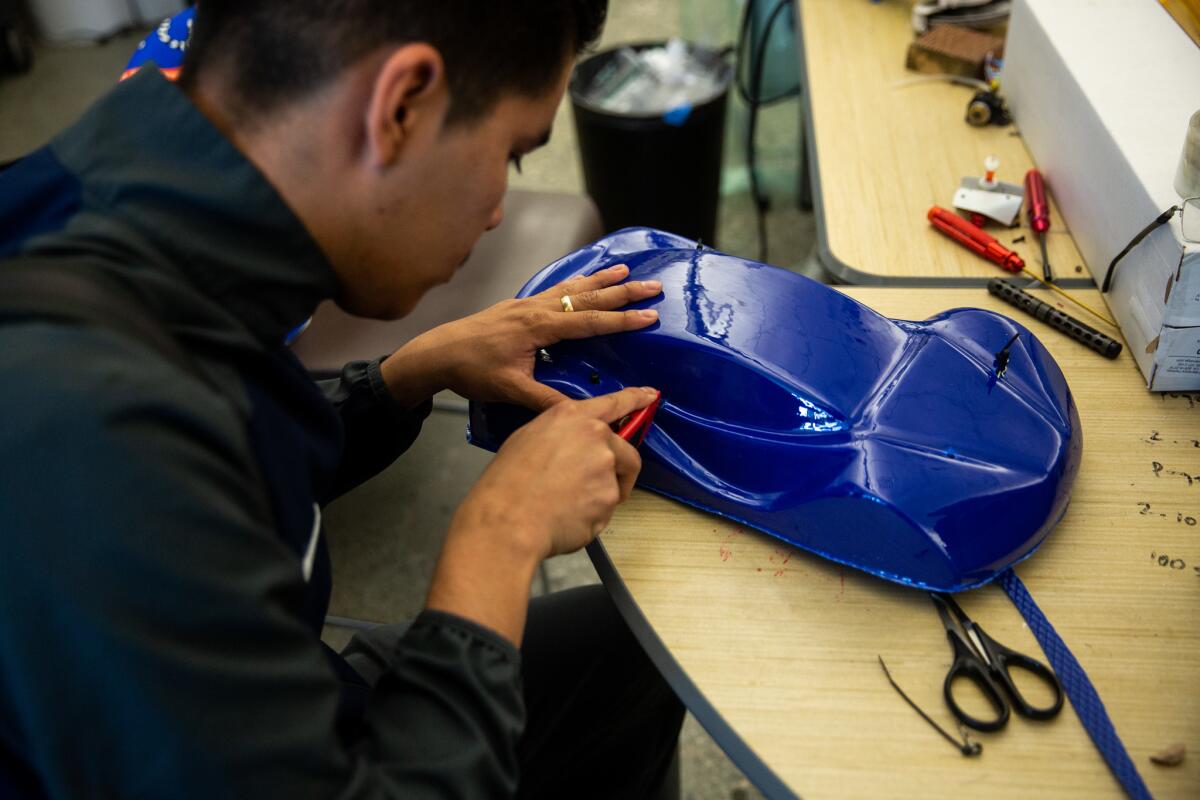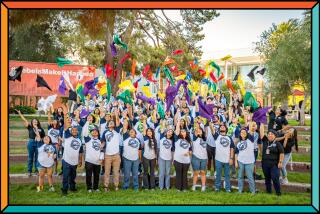L.A. Latino students take prize in Prague, could help conquer climate change

The remote-controlled car sped along the miniature race track, dodging its competitors and hugging the makeshift walls as it navigated steep curves.
The STEAM Legacy High School car — identifiable by its school colors, orange and blue — continued to surge ahead for six long hours. Andy Palomera, the car’s “driver,” knew he had to keep the device steady or it would crash into the others on the track.
For the record:
8:40 a.m. July 15, 2019An earlier version of this article referred to Carlos Ibarra. The teacher’s first name is Mario.
But if his car completed the most laps, his South Gate school would win a worldwide competition — and maybe someday help reduce emissions that cause global warming.
“I trusted my mechanics and the whole team that the car was at its best, so I really didn’t have to worry about anything other than just driving,” Palomera, 15, said a few weeks later as he sat in the engineering classroom at STEAM Legacy High School in South Gate. “It actually felt like the car and I had a connection.”
Palomera was a member of a 17-person team from STEAM Legacy that won the 2019 Hydrogen Horizon Automotive Challenge (known as H2AC) in Prague on June 8. Ten team members traveled to the Czech Republic to compete in the race, using remote-controlled cars, about one-tenth the size of a real car, fueled with hydrogen cells.
It was the second consecutive year that STEAM Legacy had competed and the first in which it took first place.
The annual contest, sponsored by Horizon Fuel Cell Technologies, a company founded in Singapore in 2003, and auto-manufacturer Toyota, seeks to encourage aspiring auto engineers to find new uses of alternative fuels. Vehicles fueled with hydrogen cells, though not yet widely used, are one alternative to gasoline-powered engines.
“It’s benefiting climate change; that’s one of the big reasons why it interested me,” said Alan Gallardo, 18, a recently graduated senior on the team.
But helping curb global warming isn’t the only reason STEAM Legacy competed in the H2AC contest. The school also hopes to inspire more Latino students in Los Angeles to participate in academic fields where they have long been underrepresented.
The school was founded in 2012 by Principal Carla Barrera-Ortiz with the goal of encouraging interest, particularly among Latino students, in so-called STEAM topics—Science, Technology, Math, Arts and Engineering. There is no application process for the public school, which is part of the Los Angeles Unified School District. Residents of the neighborhoods of South Gate, Bell, Cudahy, Maywood and Huntington Park also can attend.
Latinos made up 16% of the overall workforce nationally, but only 7% of the STEM workforce, according to a Pew Research Center study released in early 2018. STEAM Legacy has an enrollment of almost 600 students, 98% of whom are Latino. Though graduation rates in 2015 for Latino students in Los Angeles County were about 80%, according to data from the California Department of Education, STEAM Legacy has an average graduation rate of 94%, according to U.S. News and World Report.
Barrera-Ortiz says 82% of students at STEAM Legacy qualify for Title I eligibility, meaning these students come from low-income families. Most are children of immigrants, or are immigrants themselves.
The principal, who came to the United States from Mexico when she was 3 years old, sees a reflection of her own family and upbringing in the parents and students at STEAM.
“I’m an immigrant too, so these children are me, and their parents are my parents.”
When Barrera-Ortiz heard about Horizon partnering with high schools for the project, she embraced the idea. Students were challenged to create a car that uses a fuel cell with a limited number of batteries, turning hydrogen and oxygen into hydrogen gas, which produces electricity that powers the car. Electric cars use rechargeable batteries, but this competition focused on vehicles that used hydrogen fuel cells with the least possible number of batteries, while the students still kept the cars running quickly and efficiently.
Though there was no specific monetary compensation for winning first place, companies were reaching out to STEAM Legacy to ask about the possibility of establishing patents for the technologies that the students came up with under the leadership of their teacher, Barrera-Ortiz said.
To reach the world finals, the team had to go through several competitions. STEAM Legacy placed in the top spots in both Southern California regional finals and the statewide finals among all competing schools — public, private and others. From there, the South Gate team moved on to the world finals, where it guided its winning car to complete almost 1,300 laps in six hours, against 19 teams representing nine different countries.
Palomera, a freshman at the time, drove the car for 4½ of the six hours. Nancy Palomera says her son has loved tinkering with cars since he was a little boy.
“Everything that they’re learning is something that maybe, back in my day, maybe if I had had it, I wouldn’t have dropped out of school,” she said.
Three weeks after their first-place finish, students, teachers and relatives gathered in the same South Gate classroom where the group had spent hours laboring over the mechanics of their hydrogen-fueled vehicle. The students switch easily between English and Spanish, laughing at inside jokes and poking fun at each other.
Edwin Mijangos, 18, who emigrated from Guatemala in 2015, said that everyone’s ease with Spanish made him feel more accepted than he’d felt at his previous school.
“When I first got to the U.S., people would tell me, ‘You don’t know English, so you can’t do anything,’ ” Mijangos said.
But Mario Ibarra, the teacher directing the engineering team at STEAM Legacy, gave Mijangos a different perspective even before he joined the school.
“Mr. Ibarra told me you have the machines, you have the room, our doors are open to you, so sit here with everyone, and if you have questions, just raise your hand.”
In a school that is about 70% male and 30% female, Barerra-Ortiz is still trying to attract more females. It took a while for the two girls on the engineering team this year to build their self-confidence to a point where they could trust that they belonged.
“When I first started the program, there was definitely this feeling of ‘what am I doing here?’ when I looked up and just saw a bunch of guys who were very confident in what they were doing,” recalled Jennifer Hernandez, 17.
Her friend Nidia Ibarra, 16 — who is also the engineering teacher’s daughter — sometimes feels like her input is pushed to the side, she said, but she’s learned that her suggestions are just as valuable as anyone else’s.
“But we both wish there were more girls here,” she added.
Hernandez graduated from STEAM Legacy in June and will study computer science at UC Santa Cruz in the fall. According to a 2016 study by the National Science Board, women make up 50% of the entire college-educated workforce but only 29% of the science and engineering workforce.
In high school, boys are much more likely to take computer science and engineering courses than girls are, the study says. For example, girls took Advanced Placement computer science at a rate of 19% in 2016, while boys took it at a rate of 81%. The numbers are even lower for Latina students in high school and beyond. In 2015, Latinas made up only 2% of the STEM workforce, according to the National Science Foundation.
Besides Hernandez, other students in the group will be going off to study mechanical engineering and automotive technology, among other subjects.
One recent morning, they took out their first-place trophy from a locked glass shelf and showed off the cars they had built, pointing to the different parts they’d fixed and touched up hundreds of times.
“This is the classroom that I’m going to miss most when I leave,” Mijangos said, draping his arms around his smiling teammates. “It always makes me feel at home.”
More to Read
Sign up for Essential California
The most important California stories and recommendations in your inbox every morning.
You may occasionally receive promotional content from the Los Angeles Times.










